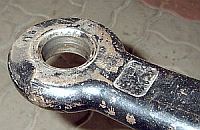Tow bar
A tow bar or tow bar connects two vehicles for the purpose of transmitting power in two directions.
It is used in the event of an accident for towing , in the absence of a drive motor for maneuvering and in exceptional cases also for support in difficult conditions (e.g. steep inclines, difficult terrain). In connection with rail vehicles, one no longer speaks of tow bars, but of coupling rods .
The main advantage of a tow bar is the considerable reduction in the risk of collision compared to a tow rope due to the possibility of transferring pushing forces when braking. In addition, especially for inexperienced drivers, a more uniform acceleration is made possible, which contributes to avoiding uncomfortable and wear-inducing jolts. Maneuvering, for example backwards into a workshop, is only possible with a tow bar, but not with a tow rope.
Execution and connections
Tow bars (cars or trucks) are not standardized. There are different versions from different manufacturers. Modern and therefore still safe tow bars are suitable for the standard towing eyes and trailer hitches on cars . Versions that attack the AHK are particularly suitable because there a particularly large power transmission is possible and, in contrast to the system with hooks on the rod and eyes on the vehicle, where there can sometimes be a play of a few centimeters, a very small one There is play when the force is reversed (braking process after tensile load or vice versa).
- Cars are mostly two or three-part square profiles or tubes that are pushed into one another and locked with pins to make assembly easier and to reduce the packing size. Hooks are attached to the ends as well as locking brackets that can be pushed into the open side of the hook to prevent slipping out of the eyelet on the vehicle.
- On trucks, tow bars with eyes on both sides are used for the usual jaw couplings, which are usually also available at the front on trucks.
In many older motor vehicles, the towing eye can be rusty or too weak. Therefore, in unclear cases, the strength should be checked if possible and the use of a tow bar should be restricted to the absolutely necessary amount.
Commercial towing
When towing by commercial companies, the regulations of occupational safety law must also be observed. According to § 47 UVV (VBG12 vehicles), for example, the attachment of the so-called rigid connecting parts (tow bar) represents a particularly high risk respectively. When towing / towing vehicles with a gross vehicle weight of more than 4,000 kg , tow bars must be used.
Use on trucks
Tow bars are also widely used for towing trucks . The construction of the two ends is similar to a trailer drawbar with two eyes. To tow a truck with a bar, it must also have a trailer coupling on the front. This is usually simplified only with a fork, in which a bolt is pushed through the eye of the tow bar. On the towing vehicle, the rod is hooked into the standard towing device. On many newer trucks, a front towing eye often only needs to be screwed in and then often not attached in the middle, but rather offset. Due to the inevitable diagonal pull with the tow bar, readjusting is even more difficult than with a central pull point.
Norms
- DIN ISO 5422 standard, 1985-01 Road vehicles; Eyelets for tow ropes, wire ropes and tow bars
- VG 74057 standard, 1990-05; Tow bars; Dimensions, requirements

